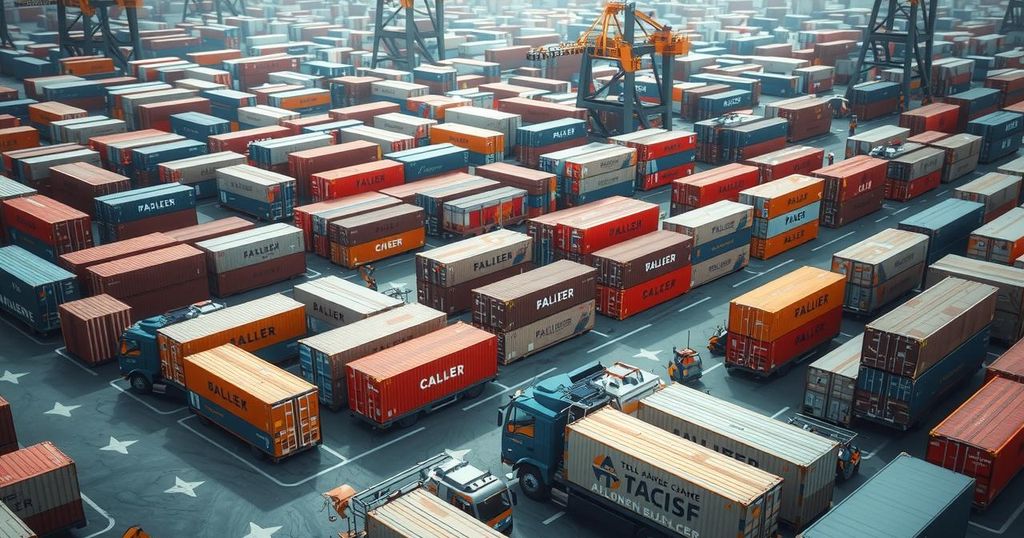President Trump’s implementation of tariffs on imports from Canada, Mexico, and China is expected to lead to significant economic impacts, including rising consumer prices, disruptions in various industries, and potential retaliatory actions from trading partners, raising the specter of an escalating trade war.
As President Donald Trump implements sweeping tariffs on imports from Canada, Mexico, and China, there will be significant economic impacts on American businesses and consumers. The tariffs, which include a 25 percent fee on most goods from Mexico and Canada and increased duties on Chinese imports, are anticipated to trigger price increases across multiple sectors including retail, automotive, agriculture, and manufacturing. Economists are concerned about potential inflation, supply chain disruptions, and overall economic volatility due to these trade policies.
Initially, Trump paused the tariffs for one month while seeking agreements from Canada and Mexico to control illegal drug and migrant flow into the US. However, he later reinstated the tariffs immediately, dismissing any further delay. Simultaneously, he imposed an additional 10 percentage point increase on tariffs for Chinese goods. Trump claims these tariffs are essential to defend American businesses, generate government revenue, and compel foreign nations to adopt fairer trade practices.
The tariffs will likely lead to higher consumer prices, as the impacted countries represented 43 percent of the $3.1 trillion in goods imported by the US in 2023. Essential items like electronics, clothing, and groceries are expected to see price hikes. For instance, China’s exports included $210 billion worth of consumer goods last year, implying that anticipated tariff increases might push up prices significantly, affecting everyday Americans.
The grocery sector is particularly vulnerable, as the US imported nearly $10 billion in vegetables and over $11 billion in fruits and juices from Mexico in 2023. Given Mexico’s dominance in avocado exports and other food products, the new tariffs may exacerbate current food inflation, thus increasing the financial strain on households.
Furthermore, the automotive industry is likely to experience disruptions due to heavy dependence on cross-border trade. With over half of the automotive parts utilized in the US sourced from Canada and Mexico, tariffs will raise import costs for essential components, potentially leading to heightened vehicle prices or diminished features. Manufacturing overall is also at risk from increased raw material costs due to tariffs, heightening production expenses and diminishing the competitiveness of domestic industries.
The financial markets responded negatively to the tariff announcements, with notable declines in major indexes, such as a 1.8 percent drop in the S&P 500. Early indicators suggest economic stress, with surveys showing diminishing consumer confidence and escalating inflation expectations. Reports indicate manufacturing companies are already feeling the impact, with many pausing new orders due to rising costs.
The prospect of retaliatory actions from trading partners arises as a significant concern. China has already initiated tariffs on American goods, and both Canada and Mexico have signaled intentions to respond likewise. Alarmingly, Trump’s executive orders include conditions for further tariffs in response to any retaliatory measures, potentially igniting an unpredictable trade war marked by reciprocal tariff increases that could disrupt global trade further.
This wave of tariffs is expected to have a larger impact than those during Trump’s first term, as they encompass a broader range of consumer goods. Despite previous low inflation rates during his first term, the current economic landscape is characterized by persistent inflation pressures. Should tariff-induced price increases occur, it may compel the Federal Reserve to sustain higher interest rates longer, ultimately slowing economic growth and increasing borrowing costs for consumers and businesses alike.
In conclusion, President Trump’s tariffs on imports from Canada, Mexico, and China are projected to have far-reaching economic consequences for American consumers and businesses. Price increases on essential goods, disruptions in the automotive industry, and impacts on manufacturing are among the primary concerns. Furthermore, the potential for retaliatory tariffs may escalate into a full-blown trade war. Overall, these tariffs could complicate economic recovery by exacerbating inflation and slowing growth.
Original Source: www.firstpost.com




